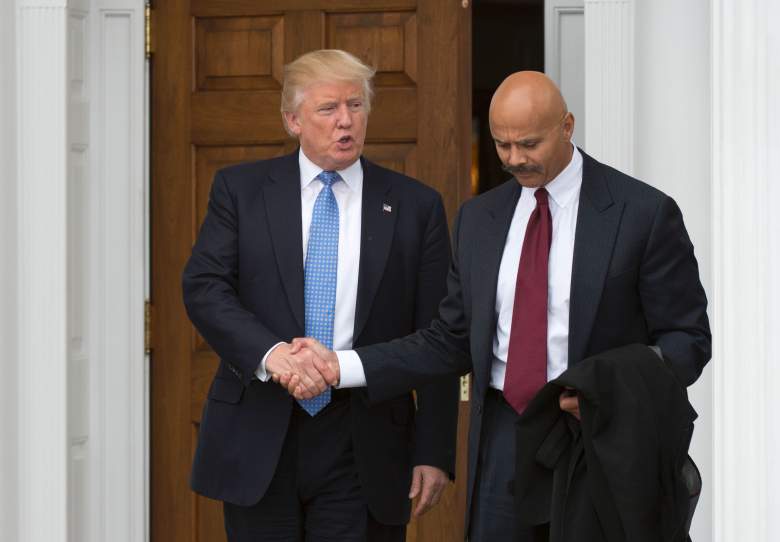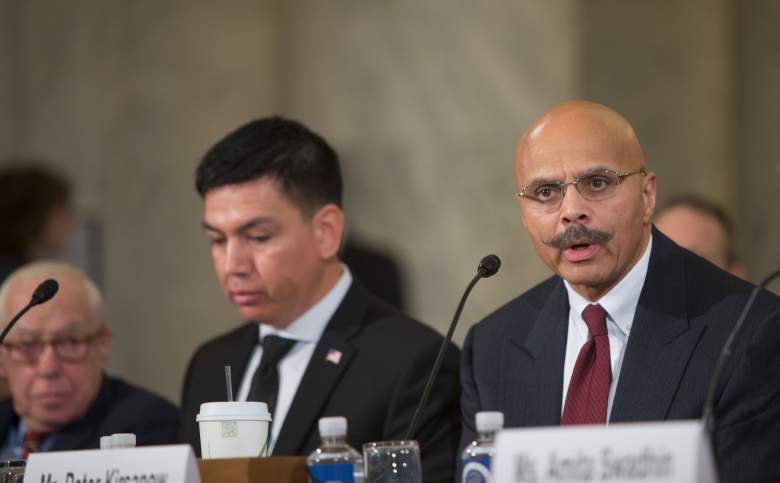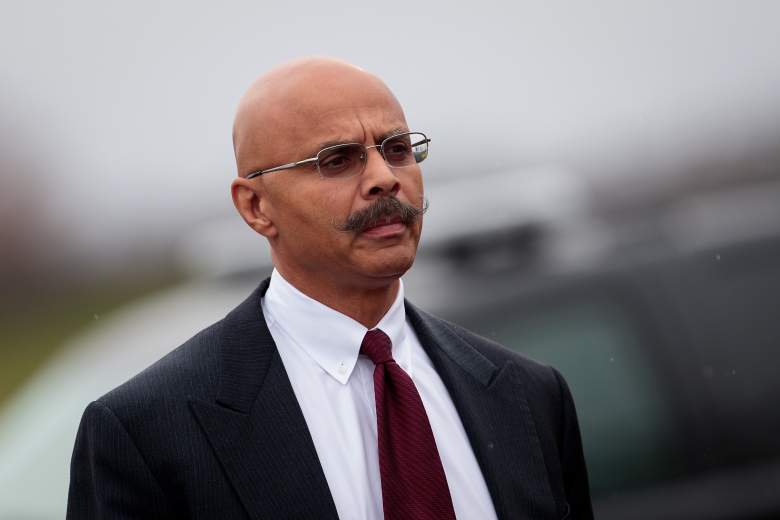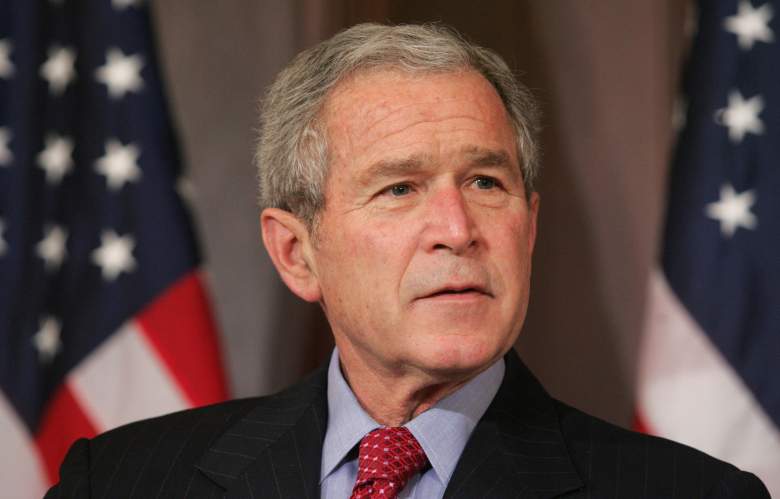
Donald Trump meets with Peter Kirsanow at the clubhouse of Trump National Golf Club on November 20, 2016. (Getty)
Peter Kirsanow is reportedly one of the leading contenders to be President Donald Trump’s nominee for secretary of labor.
This comes as Trump’s original pick for the position, Andrew Puzder, withdrew his name from consideration following reports that several Republicans in the Senate were planning to vote against him.
Bloomberg’s Jennifer Jacobs reported on Wednesday evening that there are four candidates to replace Puzder: Catherine Templeton, the former secretary of the Department of Labor, Licensing and Regulation for South Carolina; Joseph Guzman, a professor at Michigan State University; Alexander Acosta, dean of the Florida International University College of Law in Miami; and Peter Kirsanow, an employment lawyer and member of the U.S. Commission on Civil Rights.
Here’s what you need to know about Peter Kirsanow, one of the candidates to be the next secretary of labor.
1. He Was Appointed to the U.S. Commission on Civil Rights By President Bush in 2001
Peter Kirsanow is from Cleveland, Ohio, born there in October 1953. He studied at Cleveland State University and Cleveland-Marshall College of Law, and he served as labor counsel for the city of Cleveland, Ohio.
But he became more well known in 2001, when he was appointed by President George W. Bush to serve on the U.S. Commission on Civil Rights. He was appointed to fill the seat of a President Clinton appointee, Victoria Wilson, who, in turn, had been appointed to fill the seat of Leon Higginbotham, who had died in the middle of his term. Republicans argued that Wilson was only entitled to serve for the two years that were remaining in Higginbotham’s term, while Democrats argued that she should receive a full six-year term starting when she took over for Higginbotham.
This fight was taken to court, with a district court judge in early 2002 ruling that Kirsanow had no right to serve on the commission, but this was reversed by the appeals court, and the Supreme Court did not intervene. Kirsanow was able to be seated on the Commission on Civil Rights, then, and he remains on the commission to this day.
2. He Served on the National Labor Relations Board

Peter Kirsanow speaks at the Senate Judiciary Committee hearing on nomination of Sen Jeff Sessions on January 11, 2017. (Getty)
Outside of the U.S. Commission on Civil Rights, Peter Kirsanow has also served as a member of the National Labor Relations Board, being appointed in 2006.
During his time on the NLRB, he was involved in a variety of important decision. One of these came in 2006 when, in the case of Oakwood Healthcare, Inc., 348 NLRB NO. 37, the board expanded the definition of the word “supervisor” in the National Labor Relations Act. This was a decision criticized by labor unions because employees classified as supervisors would not be able to join unions and collectively bargain.
The dissent criticized the decision as “threaten[ing] to create a new class of workers under federal law: workers who have neither the genuine prerogatives of management, nor the statutory rights of employees,” according to On Labor.
3. He Writes For National Review
Peter Kirsanow has contributed some writing to the conservative website National Review, with his most recent piece being published immediately after the November election.
In an op-ed from November 9th, Kirsanow predicts that under Donald Trump, the news media will treat the president critically in a way that they did not treat President Obama.
“Beginning as early as today, but definitely by January 20, 2017, the mainstream media will discover a host of problems, dangers, failures, troubles, mistakes, and catastrophes that somehow escaped their attention, or were considered unimportant, during the last eight years under Obama,” he writes.
In another, he argues that the president and the media have lied about the frequency at which shootings of black men occur at the hands of white police officers.
“There is (and has been for some time) substantial evidence that blacks are not shot at disproportionate rates, at least not disproportionate to the rates blacks are involved in crime or conduct that otherwise triggers interaction with police,” he writes. “…The president knows this. So does his attorney general and the presumptive Democratic nominee for president. The members of the media should know it, otherwise they should be in a different profession. Yet each continues to traffic in falsehoods — falsehoods that are the political equivalent of shouting ‘Fire!’ in a crowded theater; falsehoods that provide convenient rationales for bad actors. ”
In an article from June 2015, he mocks transgender people by sarcastically saying that he identifies as a number of famous athletes.
“Today, I’m identifying as LeBron James,” he writes. “I plan to identify as Miguel Cabrera later this summer, although I’m flirting with the idea of being Mike Trout. This fall, I’m thinking Tom Brady. (Please don’t alert Giselle Bundchen. I want it to be a surprise).”
4. He Lines Up With Trump On Illegal Immigration
One issue Kirsanow has spoken extensively on is illegal immigration. For National Review, he has written a number of articles on the subject including one titled “Americans Are Right to Worry about Illegal Aliens and Crime.”
In March 2016, Kirsanow testified before the Senate Subcommittee on Immigration and said that undocumented immigration has a disproportionately negative impact on the wages of black Americans.
“Illegal immigration has a disparate impact on African-American men because these men are disproportionately represented in the low-skilled labor force,” he said. “…People often say, ‘Well, illegal immigrants are taking jobs that Americans do not want to do. No one wants to be a hewer of wood or a drawer of water.’ The problem is that there are thousands of Americans, and always will be thousands of Americans, who find that those jobs are the only ones for which they are qualified. How can you better yourself if you cannot even get on the first rung of the employment ladder and find yourself essentially shut out of certain industries?”
In 2015, Kirsanow wrote a letter to Congress saying that an executive order from President Obama allowing undocumented immigrants to get Social Security numbers and driver’s licenses would result in increased voter fraud.
“Even if an ineligible voter does not sway the outcome of an election, his vote still chips away at the legitimacy of the voting system,” Kirsanow said, according to The Washington Times. “Every person who votes despite being ineligible cancels out the vote of an eligible voter.”
5. He Met With Trump to Speak About Labor Issues in November 2016

Peter Kirsanow arrives for a meeting with Donald Trump at Trump International Golf Club on November 20, 2016. (Getty)
One reason Kirsanow is a strong contender for the role is that he actually already met with Trump and spoke about labor issues back in November.
As reported by Cleveland.com at the time, Kirsanow met with then president-elect Trump at Trump National Golf Club in late November; he told reporters at the time that he and Trump talked about labor and employment generally but did not discuss a specific position.
Kirsanow told Cleveland.com after the interview that “I know my stuff when it comes to labor, and I will tell you that I was not just impressed but astonished at his understanding of not just labor dynamics but of labor law itself.”
He also said he talked to Trump about the idea of undocumented immigration hurting African Americans during the meeting.
